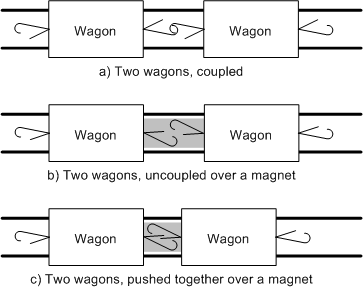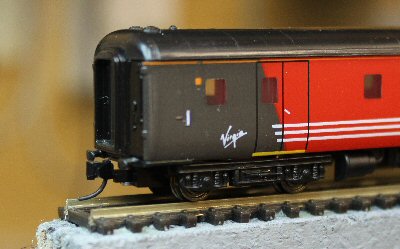An alternative style of coupling is the "Micro-Trains" coupler that is common on American models. It is the N gauge variant of the "Kadee" coupler. A Micro-Trains coupler is a variant of the "knuckle" coupler and it operates in quite a different way. It is physically smaller than the standard UK coupler, although it is fair to say that both are disproportionately large compared with might be found of a real train!
The Micro-Trains coupler is magnetically operated, but in a different way from the Peco coupler. It is also controlled by a piece of iron wire, but it moves laterally not vertically. To couple two pieces of rolling stock together, simply drive one into the other and the couplings will join. They will then stay connected and reliably so (picture a).
To uncouple a Micro-Trains coupler, the train must be reversed while the coupling is over a magnet. (That can be a permanent magnet, or an electromagnet). This releases the pressure from the connection, and the iron wires are attached towards the rails. When that happens the two couplings separate laterally, toward the rails. The train can then be moved apart: see picture (b).

If the train is then pushed together while still over the magnet, the coupling does not mate. Instead it goes together in a way that allows the train to move but does NOT couple (picture c). This allows that coupling to be moved to a different part of the track without re-coupling. For a shunting operation this is useful: the train can be separated where the magnet is, then moved to where the rolling stock needs to be left.
The end result is a coupling that couples reliably, and uncouples reliably. It is less obtrusive than the "UK standard" coupler. Here's one installed to a UK carriage. You can see clearly the black "knuckle" coupler, and the gold coloured iron wire that operates it.

